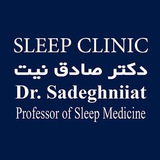🌓 اختلالات خواب ناشی از شب کاری
اختلال خواب افراد شب کار بر عملکرد، ایمنی و سلامت آن ها تأثیر دارد. آزمون سنجش خواب آلودگی طی روز (Multiple Sleep Latency Test (MSLT می تواند یک ارزیابی قابل اعتماد از اثرات محرومیت از خواب را ارایه دهد. محدود کردن خواب شبانه به 5 ساعت در یک شب منجر به افزایش قابل توجه خواب آلودگی فرد می شود و بعد از 2 شب منجر به کاهش Sleep Latency می گردد. شیفت کاران نسبت به افراد غیر شیفت کار بیشتر چرت می زنند و طول مدت چرتشان هم طولانی تر است و با این کار کمبود خواب خود را جبران می کنند.
📚 برگرفته از کتاب اختلالات خواب و فعالیت های شغلی نوشته دکتر صادق نیت و دکتر امینیان
#شب_کاری #نوبت_کاری #MSLT
🆔 @drsadeghniiat
🌐 www.iransleep.com
اختلال خواب افراد شب کار بر عملکرد، ایمنی و سلامت آن ها تأثیر دارد. آزمون سنجش خواب آلودگی طی روز (Multiple Sleep Latency Test (MSLT می تواند یک ارزیابی قابل اعتماد از اثرات محرومیت از خواب را ارایه دهد. محدود کردن خواب شبانه به 5 ساعت در یک شب منجر به افزایش قابل توجه خواب آلودگی فرد می شود و بعد از 2 شب منجر به کاهش Sleep Latency می گردد. شیفت کاران نسبت به افراد غیر شیفت کار بیشتر چرت می زنند و طول مدت چرتشان هم طولانی تر است و با این کار کمبود خواب خود را جبران می کنند.
📚 برگرفته از کتاب اختلالات خواب و فعالیت های شغلی نوشته دکتر صادق نیت و دکتر امینیان
#شب_کاری #نوبت_کاری #MSLT
🆔 @drsadeghniiat
🌐 www.iransleep.com
Forwarded from اتچ بات
🏥 Human Leukocyte Antigen-Typing in Patients with Excessive Daytime Sleepiness
Background and Objective: Narcolepsy is a disorder recognized by excessive daytime sleepiness (EDS). Several studies demonstrated its association with human leukocyte antigen (HLA) DQB1*0602, DQA1*0102, and DRB1*15. Our study aimed to perform HLA-typing on patients with EDS. Moreover, we performed HLA-typing for family members of the patients.
Materials and Methods: We studied 83 patients with EDS and 77 of their first-degree relatives. Patients filled out a questionnaire including Epworth Sleepiness Scale (ESS), and underwent polysomnography (PSG) and multiple sleep latency test (MSLT). The whole blood samples were drawn from the patients and their families for HLA typing (class II). International classification of sleep disorders-2 (ICSD-2) criteria was used as the gold standard for diagnosing narcolepsy.
Results: HLA DQB1*0602 was present in 20 (45.5%) of narcoleptic patients and 2 (5.1%) of patients with other causes of EDS. Prevalence of DQB1*0602 in family members of narcoleptic patients were higher than family members of patients with other causes of EDS (38% vs. 11.1%, P = 0.06). DQB1*0602, DQA1*0102, and DRB1*15 were more prevalent in narcoleptic patients with cataplexy than narcoleptic patients without cataplexy and patients with other causes of EDS. The sensitivities of the DQB1*0602 for diagnosing narcolepsy, narcolepsy with cataplexy, and narcolepsy without cataplexy were 40%, 60%, and 20%, respectively; while specificities were 93.9%, 87.9%, and 70.6%, respectively.
Conclusion: HLA typing can be helpful in patients with atypical cataplexy and inconclusive MSLT results. More studies of Iranian narcoleptic patients are required for analyzing their HLA sequences.
#Research #sleep #narcolepsy #MSLT
🌐 http://jss.tums.ac.ir/index.php/jss/article/view/76
🆔 @drsadeghniiat
Background and Objective: Narcolepsy is a disorder recognized by excessive daytime sleepiness (EDS). Several studies demonstrated its association with human leukocyte antigen (HLA) DQB1*0602, DQA1*0102, and DRB1*15. Our study aimed to perform HLA-typing on patients with EDS. Moreover, we performed HLA-typing for family members of the patients.
Materials and Methods: We studied 83 patients with EDS and 77 of their first-degree relatives. Patients filled out a questionnaire including Epworth Sleepiness Scale (ESS), and underwent polysomnography (PSG) and multiple sleep latency test (MSLT). The whole blood samples were drawn from the patients and their families for HLA typing (class II). International classification of sleep disorders-2 (ICSD-2) criteria was used as the gold standard for diagnosing narcolepsy.
Results: HLA DQB1*0602 was present in 20 (45.5%) of narcoleptic patients and 2 (5.1%) of patients with other causes of EDS. Prevalence of DQB1*0602 in family members of narcoleptic patients were higher than family members of patients with other causes of EDS (38% vs. 11.1%, P = 0.06). DQB1*0602, DQA1*0102, and DRB1*15 were more prevalent in narcoleptic patients with cataplexy than narcoleptic patients without cataplexy and patients with other causes of EDS. The sensitivities of the DQB1*0602 for diagnosing narcolepsy, narcolepsy with cataplexy, and narcolepsy without cataplexy were 40%, 60%, and 20%, respectively; while specificities were 93.9%, 87.9%, and 70.6%, respectively.
Conclusion: HLA typing can be helpful in patients with atypical cataplexy and inconclusive MSLT results. More studies of Iranian narcoleptic patients are required for analyzing their HLA sequences.
#Research #sleep #narcolepsy #MSLT
🌐 http://jss.tums.ac.ir/index.php/jss/article/view/76
🆔 @drsadeghniiat
Telegram
attach 📎
